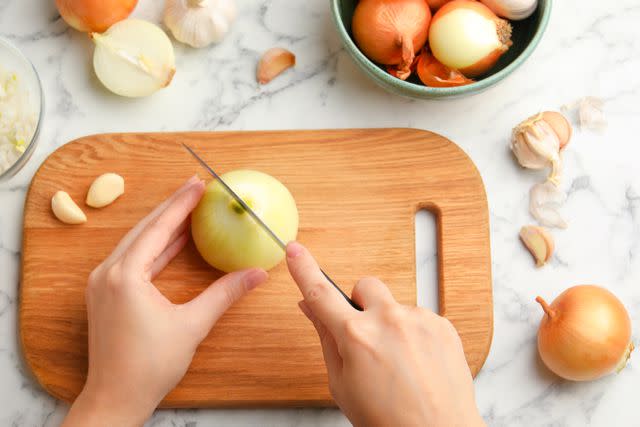Sweet Onion vs. Yellow Onion: An Expert Explains the Difference
A food scientist teaches us the difference between the two onions.
:max_bytes(150000):strip_icc():format(jpeg)/Simply-Reicpes-Onion-Difference-LEAD-01-1f8a6e76c2514292ab5149cc790afae8.jpg)
Simply Recipes / Getty Images
I must admit that as a child, I wasn’t the biggest onion fan. They weren’t included in many of my family meals and while I could tolerate them in cooked recipes, I developed a real aversion to onions served raw.
However, as time went on, I began to appreciate the nuance and flavor both raw and cooked onions can bring to recipes. Now ,they’re part of my day-to-day culinary life.
One of my favorite things about onions is that there are so many kinds, each bringing its own nuances to a dish. So, while you might not think it matters whether you choose a sweet versus a yellow onion for your recipe, you will be surprised to learn that there’s a world of difference between them. I spoke with a food scientist who illuminated the unique characteristics of sweet onions versus yellow ones.
What Is the Difference Between a Sweet Onion and a Yellow Onion?
At first glance, sweet onions are larger bulbs with thinner skins compared to yellow onions, which tend to have thicker, darker, more papery skins and are smaller in size.
More important for your cooking is the flavor difference. “Sweet onions are bred to have less sulfur,” says Abbey Thiel, PhD, food scientist, consultant, and educator. “However, the temperature, amount of water, and nutrients in the growing soil will affect how strong the flavor will be in both onion varieties.”
Sweet onions tend to be grown in low-sulfur soil. While they do have a higher sugar content, this lack of sulfur typically makes sweet onions more mellow and lends them their namesake flavor. “They simply taste sweeter due to the low level of pungency, allowing their sweetness to shine through,” Thiel explains. Sweet onions also have a high water content, yielding a juicier, milder product compared to yellow onions.
Yellow onions’ higher sulfur content results in the sharp taste and eye-watering intensity that many people associate with onions in general. Thiel explains that yellow onions can also be grown in a wider variety of environments, including high-sulfur soils, which enhance their piquant taste. Their lower water content also concentrates their flavor and causes yellow onions to be less juicy raw and give off less water when cooking.
Read More: I Asked 4 Farmers How To Store Onions—They All Said the Same Thing

Simply Recipes / Getty Images
What are the Best Uses for Sweet Onion vs. Yellow Onion?
The differences between sweet onions and yellow onions translate to cooking, with each best suited for their own culinary applications.
“Sweet onions are ideal for raw or lightly cooked dishes because of their milder, sweeter taste and higher water content,” says Thiel. This makes them the perfect raw onion for salads, sandwiches, salsas, and crudos.
While sweet onions caramelize nicely due to their higher sugar content, Thiel explains that higher heat applications often result in loss of their signature flavor and texture. She recommends only lightly sautéing or gently caramelizing them for topping burgers, bratwurst, egg dishes, salads, or even quick-cooked and cold soups.
“Meanwhile, the stronger flavor and lower water content of yellow onions makes them better for dishes that need longer cooking times or higher heat,” says Thiel. Examples include slow-simmered soups, stews, braises, and roasted or grilled dishes (kebabs, anyone?). Go ahead and let them get dark and soft. “Yellow onions hold their shape better and develop rich, deep flavors when caramelized,” notes Thiel.
How To Pick the Best Onions
When shopping for onions at the grocery store, Thiel recommends picking bulbs that feel firm and heavy with a tight, unbroken outer layer of skin. Avoid onions that have noticeable spots or bruises, or ones that show signs of sprouting.
“Sprouted onions will have a small green shoot growing from the top, which means they’re close to going bad. While they aren’t dangerous to eat, they will taste much more pungent,” she explains. They also won’t last as long once you get them home.
The Best Way To Store Onions
To maximize their longevity and freshness, store onions in a cool, dry, well-ventilated space away from direct sunlight, like a pantry or cabinet. Plastic bags trap the moisture that leads to spoilage, so keep your onions in a basket or mesh bag so that air can circulate around them. Thiel warns against the common practice of storing your onions and potatoes together, as each releases gasses that cause the other to rot.
“Also note that the increased water content of sweet onions mean that they spoil faster than yellow onions in storage,” she says. However, both varieties can stay fresh in appropriate storage for two to three months. Cut onions should be stored in an airtight container where they’ll stay fresh in the fridge for up to a week or three to six months in the freezer.
Read the original article on Simply Recipes.

